This post was first published in April, 2019, and has been updated with recent data as of January, 2020.
In this post, I’m going to use competitive intelligence data to reverse engineer the website traffic of the 50 most successful B2B SaaS companies in the U.S.
Using that data, I’ll answer a question I’ve heard quite a bit about SaaS marketing:
What are the best digital marketing channels for B2B SaaS companies?
Of course, a marketing channel isn’t successful if it only drives traffic. B2B SaaS traffic is meaningless if it doesn’t convert to leads and–ultimately–paying customers and revenue.
And every source of traffic is different in terms of (1) how quickly it can generate leads once you start investing, (2) scalability, and/or (3) potential return on investment (ROI).
So, in this guide, I’m going to use the new data I’ve gathered–plus research, case studies, and my 10+ years of experience doing digital marketing for SaaS and other companies–to give you the insights you need to:
- design a marketing channel mix that makes the most sense for your B2B SaaS business, and
- get the most cost-effective impact (including lead generation) out of the marketing channels you decide to target.
In short, SaaS marketers, I’m going to give you shortcuts to designing a digital strategy for your SaaS marketing plan that makes the most of your time and money.
Now let’s get to the data and insights! Here are some shortcuts if you’d like to jump ahead:
Table of contents
- Overview: The best B2B SaaS marketing channels
- Direct traffic
- Organic search
- Referrals
- Social media
- Paid search
- Display ads
- Conclusion
Overview: The best B2B SaaS marketing channels
Methodology
Starting with a list of large SaaS companies compiled by
Then I pulled desktop traffic data for those 50 websites using SimilarWeb, and supplemented that data using other competitive intelligence tools.
SimilarWeb’s 3rd-party insights aren’t perfect, but since we’re looking at averages across a substantial number of large websites, we can comfortably draw conclusions about the scale of difference between the different traffic sources for these websites.
All of the raw data is available here.
Highlights of the results
This is a meaty post, so here’s a preview of some of the patterns that emerged when I dove into the data:
- Organic search (i.e., Google) is consistently the biggest source of traffic, new visitors, and often leads
for these SaaS businesses, driving up to 77% of traffic. - Referrals: The companies getting the highest share of traffic from referrals (up to 48% of traffic) have baked referrals into the core workflows of their products.
- Email accounts for less than 5% of traffic, on average, but has an incredibly high ROI, upwards of 3,800%.
- Social media: In terms of sending social traffic, YouTube has surpassed Facebook for most of these SaaS companies.
- Digital advertising: 98% of companies have run paid search campaigns in the past year, and 96% were running display ads in December, 2019. That’s up a whopping 24 percentage points from the 72% of companies running display campaigns in the beginning of 2019.
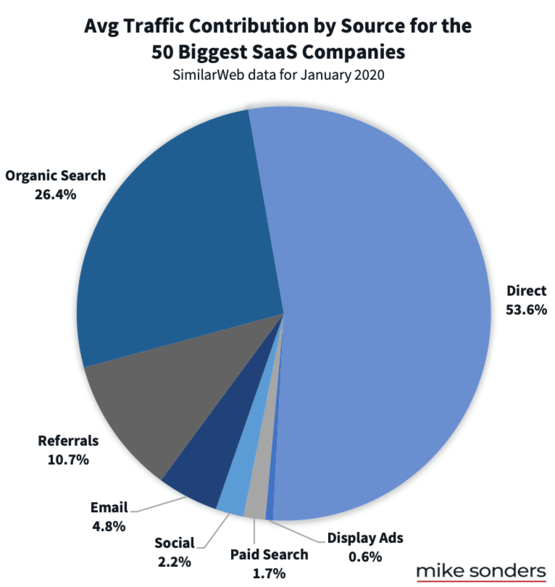
In terms of traffic, these are the biggest digital marketing channels for the largest 50 public B2B SaaS companies, in descending order:
- Direct search – 53.6% of traffic, on average. Note: I discuss below why the big number attributed to direct traffic is misleading.
- Organic search – 26.4%
- Referrals – 10.7%
- Email – 4.8%
- Social media – 2.2%
- Paid search – 1.7%
- Display ads – 0.6%
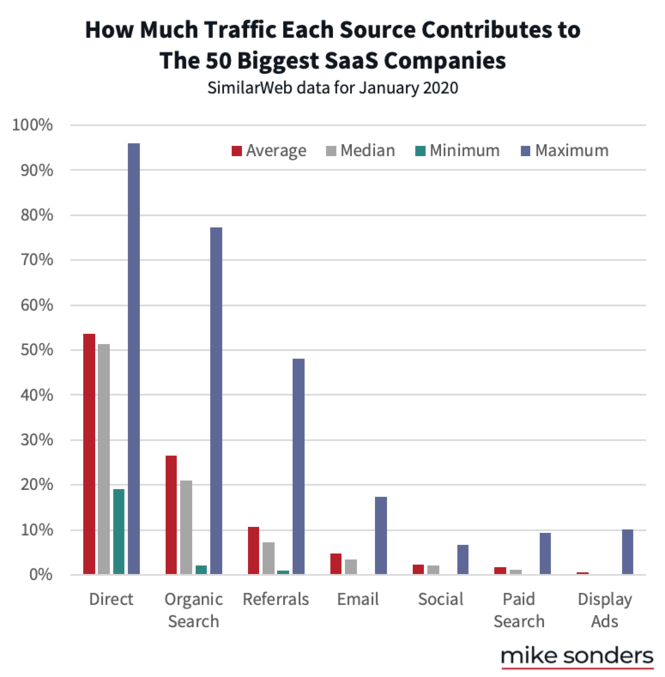
I found that not every one of these 50 companies gets traffic from every one of these channels. Paid advertising sources in particular aren’t universally adopted (although adoption of display ads is up dramatically from 2019):
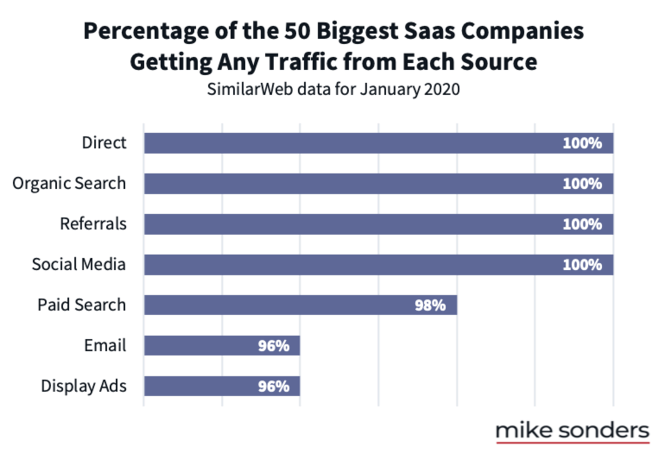
Now that we’ve reviewed the highlights, let’s dig deeper and unpack the data to uncover actionable insights for your B2B SaaS marketing strategy.
Direct traffic
Direct might look like it could be a big, important user acquisition channel, but don’t be misled.
In reality, there’s a relatively small number of new visitors who learn about a SaaS business (e.g., via an ad or word-of-mouth) and then type the business’s URL into a browser.
For SaaS websites, most direct traffic is either returning customers or misattributed traffic from other channels.
Returning customers
In my experience, for established SaaS websites the majority of (valid) direct traffic is returning customers typing a URL into a browser or clicking a browser bookmark. After all, the SaaS website is often also the product.
Misattribution
The direct channel is artificially inflated, since it’s a catchall for all traffic with missing attribution data (which can be a lot of traffic).
Misattributed direct traffic often includes visitors from organic search, emails, native mobile apps like Facebook or Twitter, text messages, Slack and other messaging apps, offline documents like PDFs, other non-web-based links, and secure (HTTPS) sites going to non-secure (HTTP) sites.
Like I said… it’s a lot.
You can improve the attribution of your traffic by adding UTM parameters to the links in your digital marketing campaigns. (But for goodness’ sake, never add UTM parameters to your website’s internal links.)
Organic search
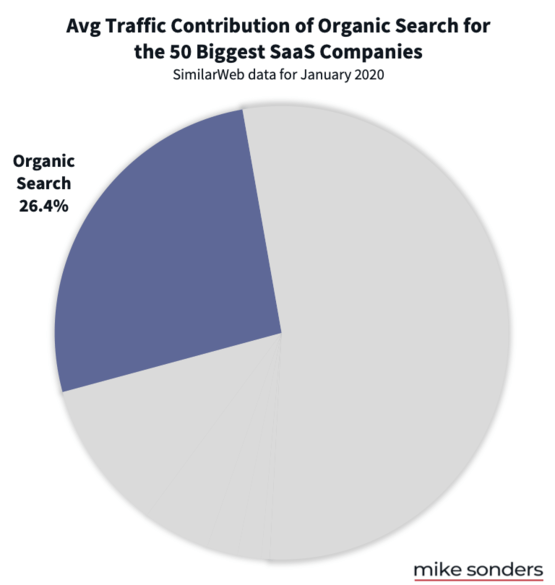
It’s difficult to overstate the importance of organic search traffic to the success of B2B SaaS companies.
Controlling for the noise from the d
(Even when you consider the number of existing customers who return to a SaaS website by Googling “[brand]” or “[brand login]”.)
And it’s not even close. On average, the biggest SaaS companies get over 26% of their traffic from search engines, which is almost 16 percentage points better than the next-best channel, referrals.
Of course, when I say “search engines”, I really mean “Google”. Google properties account for over 90% of web search volume. So from this point, I’ll use “Google” and “search engines” interchangeably.
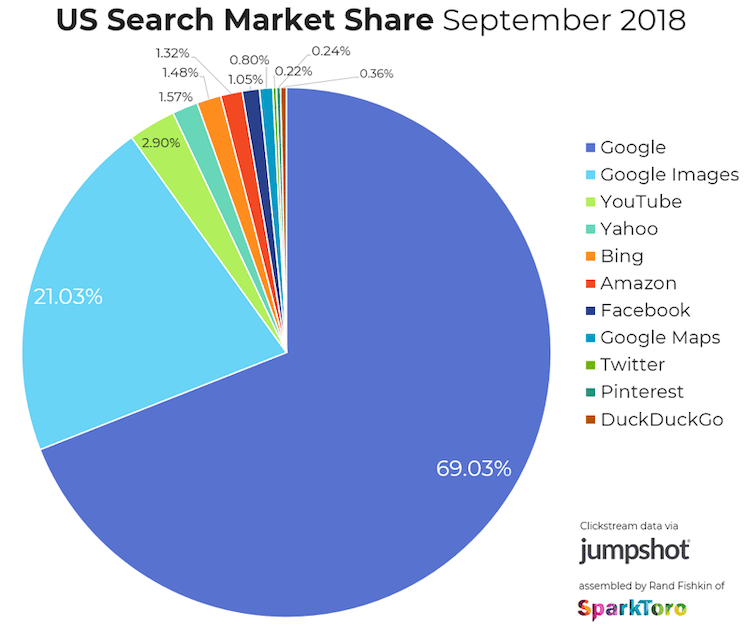
Traffic scalability
Search is a hugely scalable channel for SaaS businesses. It helps that everyone you know uses Google whenever they have a question about just about anything, producing at least 2 trillion searches per year.
For the biggest SaaS companies, the organic search opportunity translates to upwards of tens of millions of visits per month:
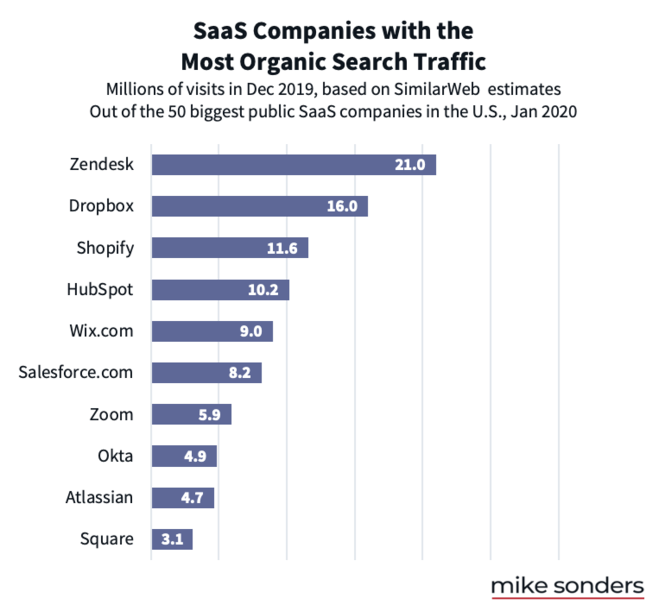
Please take the specific numbers from SimilarWeb with a grain of salt, but we can make confident conclusions about the scale of opportunity in this channel.
Thanks to its scalability, organic search can account for a huge, majority share of traffic to a B2B SaaS company’s website.
For example, Cloudera gets around 77% of its traffic from organic search (up from 68% in 2019). No other (non-direct) channel dominates the traffic mix like that among these 50 companies. The referrals channel is the closest contender, maxing out at 48% of traffic (for Docusign).
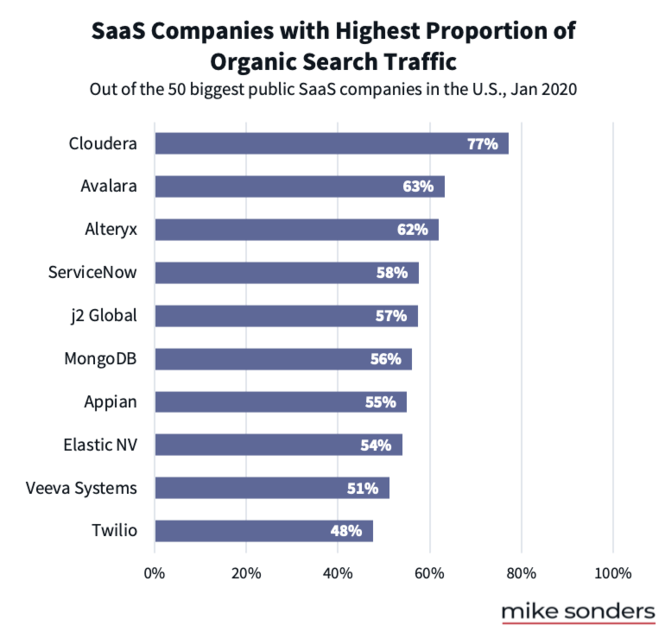
Compounding traffic effects
The magic of organic search isn’t just scalability; it’s compounding effects.
Consider content marketing, the inbound marketing strategy of choice for many B2B SaaS startups. Successful content marketing strategies rely upon search engines for the majority of long-term traffic:

An effective piece of content–whether a product page or a blog post–following SaaS website best practices can enjoy (increasing) organic search traffic for months and even years. When you consistently produce good content, the organic search traffic effects start to compound.
That’s how sites like Backlinko can publish fewer than 200 pages of content and still get upwards of a half-million visits per month–by following a content strategy that respects and leverages the power of organic search.
Lead generation
So how well can organic traffic convert to leads?
When I ran SEO and content strategy for a business unit of SurveyMonkey in 2016, we generated 30K visits per month from Google within the first year of operations, and that organic traffic from Google generated over 95% of the business’s leads.
That’s probably a bit of an outlier, given that we were early-stage company going all-in on content marketing, and hadn’t developed other, robust channels and digital marketing practices.
So consider Atlassian, one of the top five biggest, public B2B SaaS companies, where–according to Atlassian’s former Head of Technical SEO, Kevin Indig–organic search traffic accounted for over half of sales in 2017, the most recent year for which I could find data.
Beyond these anecdotes, broader research also shows that organic traffic from Google can be an incredible source of qualified leads for SaaS:
- In a survey of startup founders by Hike, 90% of respondents said that search engine optimization (SEO) was a “major driver of brand awareness and leads for their business.”
- A 2019 study of 277 digital marketers found that content marketing and SEO were rated the “most effective” marketing practices, and were the areas most-expected to see increased investment in the next year.
- In a 2017 survey of 179 B2B digital marketers, 70% of respondents said that organic search was important for generating leads, second only to email (73%).
So organic search traffic is hugely scalable–thanks to both the ubiquity of Google and to compounding effects–and can be a significant driver of lead generation for SaaS companies.
The challenge is that SEO is a long-term investment–it takes a while to generate meaningful search traffic for newer websites, even when you know what you’re doing. When there’s pressure for short-term growth and/or positive cash flow, SEO can seem less appealing since it doesn’t have an immediate payoff.
But now that you know the importance of organic search traffic and SEO to successful B2B SaaS companies, you know that the sooner your company starts investing in SEO, the sooner you’ll start seeing the long-term benefits.
Referrals
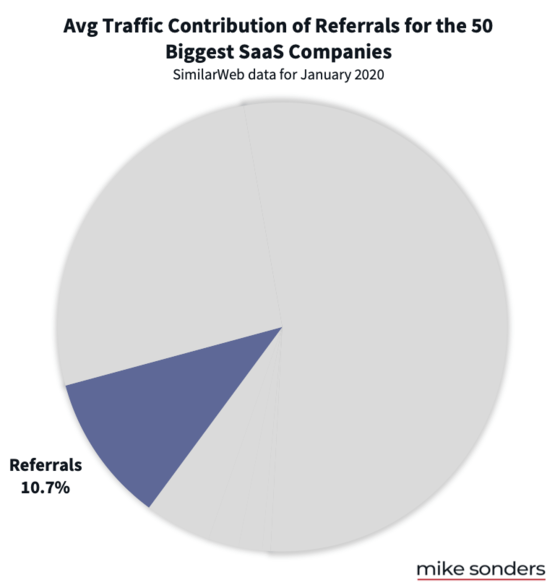
Referral traffic arrives on your website via links on other websites. On average, the biggest SaaS companies get 10.7% of their traffic from referrals, which makes it the 3rd-biggest channel for traffic, on average.
Typical methods for SaaS businesses to get links on other websites include:
- Guest posting
- PR
- Placement in app directories (e.g., Salesforce’s AppExchange, the Slack App Directory, and the Zapier app directory)
- Marketing partnerships
- Reseller and affiliate programs
- Posting in online communities (e.g., Reddit, Facebook Groups, HackerNews) and forums.
When you’re first starting out, it takes a notable amount of work to earn links back to your site. Thankfully, as people come to learn about and trust your brand and content, you’ll earn links at an increasing rate without even asking for them–but that flywheel effect takes time to happen.
Whether or not those links generate any qualified traffic to your website is a bit of a crapshoot, in my experience, and is largely dependent on:
- Relevance: How relevant is your link to the audience of the referring content?
- Traffic: How much traffic from relevant audiences does the referring content get?
- Surfacing: How well your link is surfaced in the referring content?
The most scalable way to generate referral traffic is to build it into the core workflow of your SaaS product.
Consider the SaaS companies in our dataset that have the highest proportion of their traffic coming from referrals:
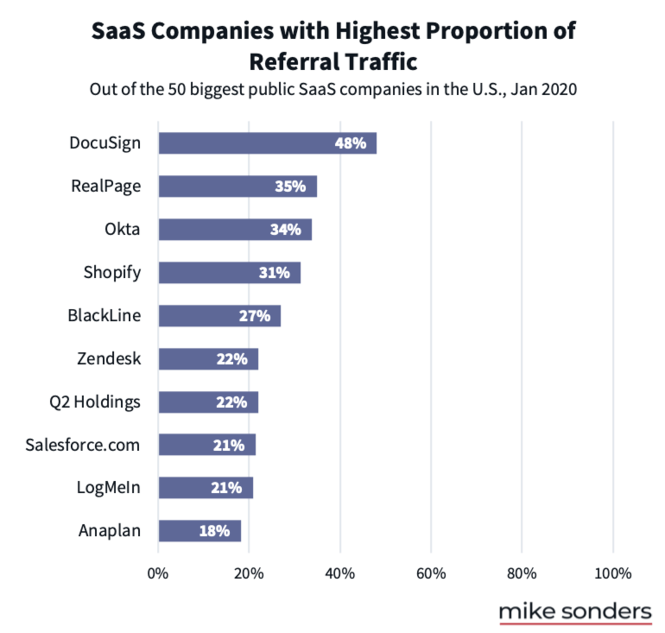
Almost all of these companies have a referral process built-in to their product workflow. For example:
- Docusign customers refer their vendors, partners, etc. to the Docusign website to e-sign legal documents.
- Company IT teams point employees to subdomains on the Okta’s website for Single Sign-On (SSO) access to various company apps.
- Property managers using RealPage point their residents to the RealPage website to pay rent, submit service requests, and more.
Not only are these companies generating scalable referral traffic, they’re also building brand awareness and affinity, which have their own multiplier effects.
Even links that don’t send referral traffic often have important value for SEO–which is partly which guest posting is so popular and sometimes abused. Google has explicitly said that backlinks are one of the top three ranking factors in its search algorithms. The more backlinks your site gets from relevant, authoritative sites, the more authoritative your site becomes–making it easier to rank on Google for your target search terms.
On average, the biggest SaaS companies get 4.8% of their traffic from web-based email clients.
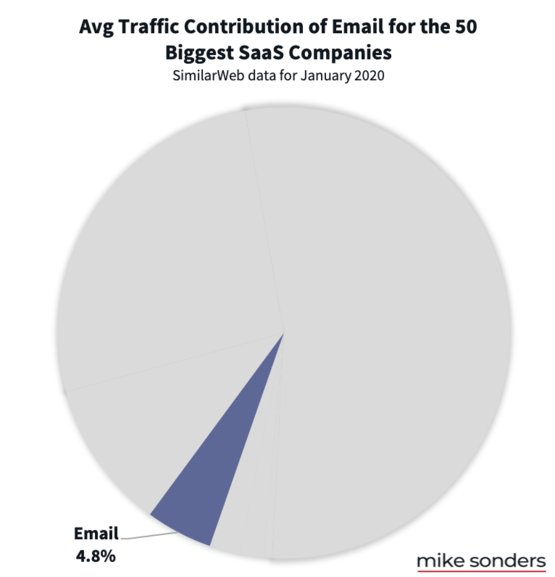
There are two major flavors of emails: warm and cold.
Warm emails
Warm emails–often synonymous with “email marketing”–are the ones you send to your “owned” email list. That is, the people who have opted-in to hear from you, e.g., by signing up for your newsletter, downloading a whitepaper, signing up for a webinar, starting a free trial, becoming a customer, etc.
Recent research indicates that the ROI on email marketing is 38:1, which is pretty damn good (and steady from levels reported in research done in 2015).
Email marketing works at every stage of your SaaS customer’s lifecycle, from nurturing leads to retaining paying customers:

If you’re a relatively new SaaS startup, I recommend having a deliberate and specific plan to grow your owned email list and nurture it–it’ll become one of your most valuable SaaS marketing assets.
Think about how nice it’ll be to have an available, warm audience for promoting your content, new features, promotions, events, and more. Plus, your owned list of lead emails will probably be your first list large enough to test in paid lookalike campaigns.
But nurturing your list is key. I see plenty of startups–and I’ve been guilty of this myself–build email lists and then ignore them. People will forget about you!
A biweekly newsletter that adds value for your target audience is a manageable way to stay top-of-mind. Because many people on your list may not be looking to buy today, but you never know about a month or year from now.
Cold emails
Most of the channels discussed so far are key to inbound marketing strategies, but this one’s a notable and important exception.
Cold email campaigns (a.k.a., “outbound sales” or “sales emails”) are ones that you send to people who haven’t had any apparent prior contact with your company.
Note: There are tools that allow you to see the companies who have visited your website (Google “website visitor tracking software”), but I still count outreach to individuals at those companies as cold if they haven’t opted-in to any of your offers.
Systematized outbound email processes are a critical component of growth for many B2B SaaS companies. Even Hubspot, which built its brand trumpeting the superiority of inbound marketing and generally talking smack about outbound marketing, admitted to using outbound techniques as early as 2010. Outbound works for generating leads, and cold emails make outbound really scalable.
Cold email guidelines
In terms of implementation, don’t trust strangers selling you lists. I’ve never heard of a B2B startup having success with a purchased email list. (Maybe it’s happened, I just haven’t heard of it.)
You’re much better off building your own cold email lists comprised of proven buyer personas who work at companies matching your ideal customer profile (ICP). You can use a lead gen service or tool, or implement your own process for finding prospects and emails at scale using LinkedIn.
At first blush, sending an email might sound like a relatively low-cost exercise. But outbound email campaigns at scale aren’t cheap:
- Prospecting: The teams getting the best response rates spend meaningful time finding, qualifying, and researching prospects. You can’t fully automate this process; it requires work from actual humans.
- Personalization: The extra time researching prospects can pay off nicely. I’ve seen this myself (having been on the sending and receiving end of cold emails), and it’s substantiated by research: One Buzzstream study of 12,000 email outreach campaigns found that emails with contextually relevant personalization got 10.7% higher reply rates than emails with basic merge-field personalization (“Hi [first_name], …”).
- Optimization: Plus, you’ll want to constantly A/B test every aspect of your emails–sender name, subject line, copy, CTAs, send time, and more. Something as simple as optimizing your subject line can more than double email open rates. Meanwhile, a high proportion of people will send your email to spam oblivion if they don’t like your subject line.
- Deliverability: It’s critical to adopt processes that help maintain your email deliverability and avoid domain blacklisting.
- Compliance: There’s a non-zero cost to making sure you comply with GDPR, CAN-SPAM, and other regulations
It’s not my area of expertise, I’ve seen firsthand how much effort goes into creating a scalable outbound sales process that actually works and has positive ROI. It’s not inconsequential.
Social media
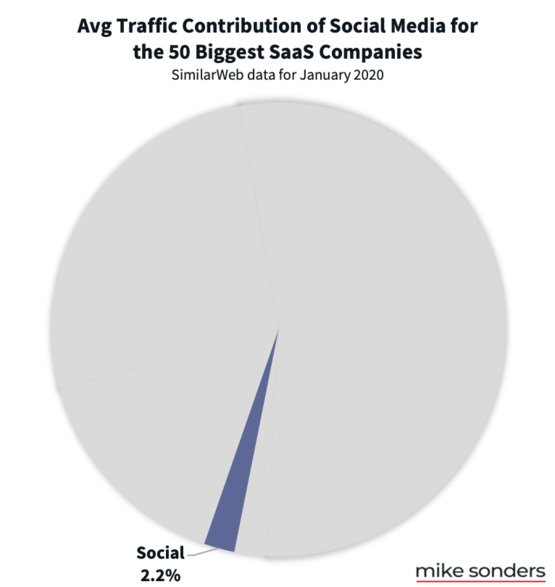
Organic social media
I always cringe a little inside when I hear someone in a B2B SaaS startup talk about “developing a social media strategy” as if organic (non-paid) social media marketing will be a meaningful driver of business.
Organic social will not be a meaningful driver of leads or revenue for your B2B SaaS business.
Any successful, scalable social media marketing strategy for B2B involves spending money.
Thanks to algorithmic changes and constantly-increasing competition, the average reach of a post on the big social platforms has cratered in recent years. As a result, engagement rates are terrible.
In a study of 43MM Facebook posts, Buffer and Buzzsumo found that engagements per post declined 65% over the 18 months leading up to Q3 2018.
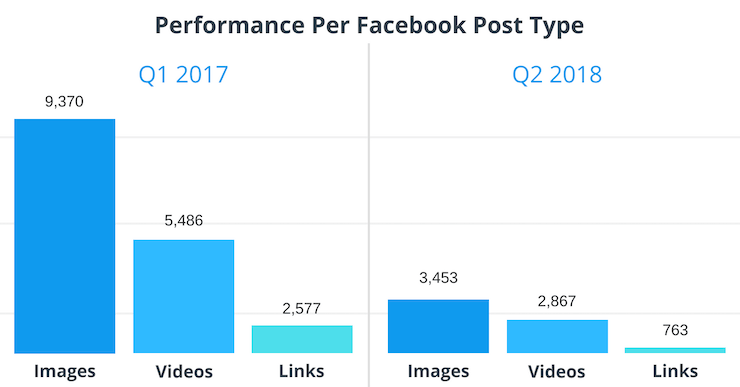
Now–according to a 2019 study looking at 4MM social posts across 12 industries–the average engagement rate per post on Facebook is just 0.09% and the rate on Twitter is 0.048%.
So businesses have a really tough time getting organic social posts in front of even a tiny fraction of their followers or fans.
Correspondingly, social media (including both organic and paid) drives only 2.2% of traffic, on average, to successful SaaS businesses.
“I often say that a ‘like’ has the same value as somebody waving at you. It’s a nice gesture, but it doesn’t mean they’re going to buy something or even come back again someday.” – Mark Schaefer
I’m not saying you should ignore the big social channels–they can still be valuable in ways I’ll describe below. Just don’t expect to uncover a repeatable process that makes organic social a scalable driver of leads and revenue.
A minimum viable organic social media strategy
For B2B SaaS startups, this streamlined approach will help you extract the most value from the organic social channel:
1. Monitor your brand mentions, @s, and comments:
A lot of people turn to social media for customer service or to complain about companies. When a company fails to respond, it can put your churn rate at risk. Conversely, people are more likely to recommend your brand when they get a quick response. So do your business a favor and have a social media customer service process in place.
2. Post regularly
There are two groups of people to keep in mind when you’re posting:
Potential customers evaluating your brand: Have you ever checked out a company’s profile on Twitter, and they haven’t posted anything for months? It doesn’t exactly instill confidence. Having an active social presence signals that your business is a going concern–not some struggling startup on the verge of death. Plus, your activity gives you an opportunity to signal your business’s positive qualities.
People who follow you on social because signing up for your email newsletter was too much of a commitment: These folks want to read (and sometimes share!) your content, get your industry insights, and maybe even hear about your product updates. Treat social like a lead-nurturing tool–stay front-of-mind and demonstrate your value. You’ll never believe who seemingly out of the blue ends up paying for your service after quietly following you for months or years on Twitter.
3. Optimize for engagement.
Social network algorithms tend to reward engagement. Better engagement increases the reach of of your organic posts… and makes your paid posts more cost-efficient. Every social platform is different (e.g., on Facebook these days, videos and images tend to get better engagement than links), so do your research and test, test, test.
At a minimum, I recommend having a brand presence on the platforms where people tend to look for and follow B2B SaaS brands–Twitter, Facebook, and LinkedIn.
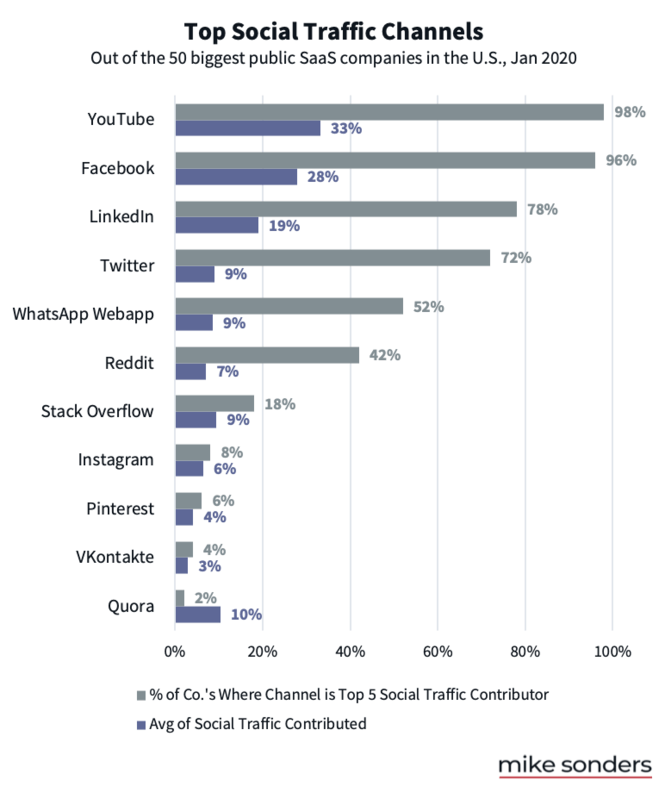
In the past year, YouTube surpassed Facebook to become the most popular social network and biggest contributor to social traffic among these companies. Facebook’s average share of social traffic dropped 15.3%, while YouTube’s increased by 11.3%.
If you’ve got the resources and skills to invest in video, YouTube is a great place for potential customers to discover “how to” content that can send clicks to your product landing pages. (Just check out the basics of YouTube SEO before you get started.)
YouTube is the top contributor of social traffic for 98% of the most successful B2B SaaS companies.
Otherwise, as with all marketing practices, start where your audience is. Maybe there’s a perfect subreddit for sharing the insights from your content. For B2C brands, it could make sense to maintain profiles on Instagram and/or Pinterest. Test, test, test!
Paid social media
Any scalable processes for nurturing and converting leads on social media involve spending money.
These are a few areas of paid social media worth your experimentation:
Social ads
Ad units like Lead Ads make it relatively easy to quickly start collecting leads without having to publish a landing page.
Test advertising campaigns that target different lookalike audiences (i.e., people who resemble the people who have already shown interest in your product or brand). In my experience, lookalike audiences tend to perform better than audiences that are simply interest-targeted… but test, test, test!
I’ve been pleasantly surprised in the past to get positive ROI for a B2B SaaS using Instagram ads–you never know what’ll work for a particular business until you try.
Remarketing
Remarketing (a.k.a., retargeting) can be a very cost-efficient way to cultivate and convert leads who have already shown interest in your SaaS’s offering.
Test remarketing different offers and content to people who have interacted with your brand online. Facebook, Twitter, LinkedIn, Google, and even Quora all have retargeting programs. (In my experience, Facebook and Google are the most popular platforms for remarketing thanks to their scale.)
Post promotion
When you have an organic post enjoying better-than-average engagement, improve its reach by paying to promote it.
You won’t just get more (cost-efficient) traffic, but also more followers–which gives you a bigger audience to which you can promote your content. A little progress every day adds up to big things, after all.
Paid search
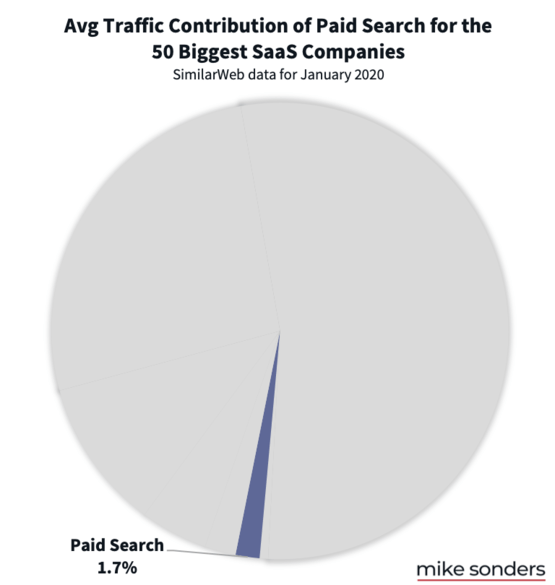
Paid search ads are the ones marked “Ad” that show up in some search results on Google and other search engines. You might see these referred to as “pay per click” (PPC) or “Google Adwords”, though Google has replaced the Adwords brand with “Google Ads”.
49 of the 50 biggest B2B SaaS companies ran paid search campaigns in December of 2019.
Unlike the case with organic search, Google isn’t the only game in town. In fact, 13 of the biggest SaaS companies bid on more search terms (“keywords”) on Bing’s ad platform than on Google’s in December, 2019.
The SaaS companies bidding on the most keywords in Google Ads tend to target consumers, sole proprietors, and small businesses–after all, there are a lot more of these customers than there are enterprise businesses in the world.
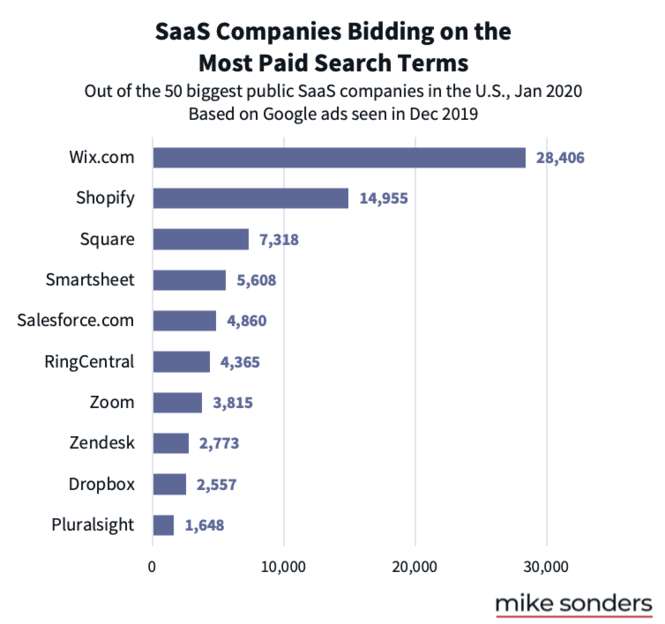
It takes a significant amount of overhead to manage paid search campaigns involving thousands of keywords and hundreds or thousands or landing pages. (That’s part of why ad agencies exist.)
But there’s no minimum requirement for starting out–you can get into the paid search game targeting just a handful of keywords. And there are plenty of 3rd-party services (Unbounce, Instapage, Leadpages, for starters…) that make it easy to generate a landing page.
Paid search can be particularly handy for early-stage startups who have a bit of a budget and need more leads, but haven’t yet developed their other marketing assets and channels. It’s a relatively quick way to test messaging and copy, and to get the company’s messaging in front of people with high purchase intent.
Ad-click prices (costs per click, or CPCs) are getting quite expensive–upwards of $100–in many SaaS verticals, so the keys to getting positive ROI with paid search are (1) finding affordable keywords with high purchase intent and (2) optimizing the hell out of your landing pages and acquisition funnel.
For quicker conversions, focus your spend on a handful of search terms that that people use when they’re deep in the buying process.
For example, you could create content that compares your solution to those of the better-known competitors in your space. Bid on the branded “vs” search terms of your competitors (e.g., “zendesk vs”) to put your lesser-known solution under consideration.
There are a handful of decent, free keyword research tools you can use to discover these terms. But I recommend investing in a robust paid tool like ahrefs or Moz so you can prioritize your target terms (“keywords”) based on search volume and competition.
Display ads
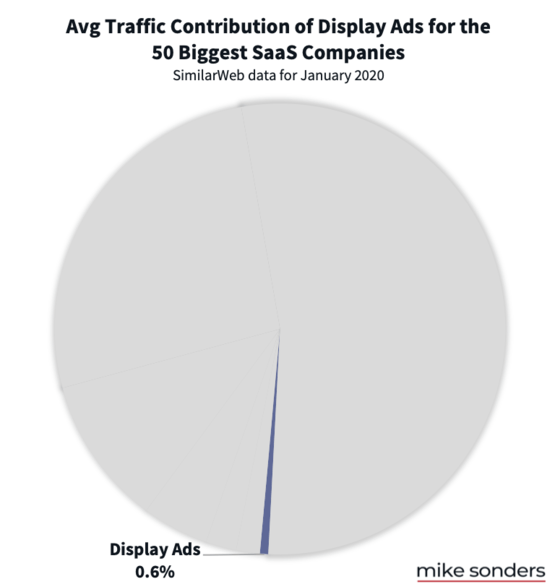
Investment in display ads is way up year-over-year: 96% of the biggest SaaS companies are running display ad campaigns in January of 2020 vs. just 72% at the beginning of 2019.
For the majority of companies running display ad campaigns, the Google Display Network is the ad network driving most of their ad traffic. Google has increased its dominance in this market by 17% year-over-year, being the top ad network for 28 companies in January, 2020, vs. 24 a year ago.
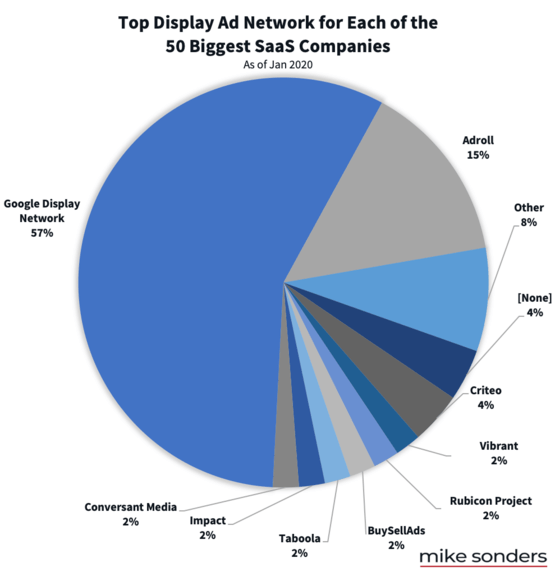
Challenges with paid digital advertising
There are quite a few challenges all types of paid digital advertising:
- Unlike other digital marketing channels, ads aren’t an investment–they’re an expense. Ads aren’t like SEO and referrals, where traffic and lead generation can continue (and even grow) even if you stop investing–as soon as you stop spending money on ads, you stop getting leads.
- Ad fatigue means continuous overhead costs. You can’t just continue to spend the same amount of money on an effective ad campaign and expect consistent results over time–thanks to ad fatigue (people getting tired of your ads) you’ll need to consistently refresh your ad creative to get and keep the attention of your target audience.
- Competitors can quickly bid up your costs. If and when a competitor increases their ad spend, prices get bid up and you’re looking at higher customer acquisition costs and a longer payback period. The only winners in this scenario are the ad network and your ad agency.
- You get diminishing returns on your money as you scale up. Once you’ve develop a successful campaign, you can’t just throw more money at it and expect similar results at a larger scale. As your spend increases, getting the same results becomes more expensive. There’s a limited number of people in your target audience who are anywhere near ready to consider your offering. Once you’ve reached them, you’re showing ads to people who are less likely to convert, which lowers your conversion rates, increases your acquisition costs, and reduces the ROI of your campaigns.
While ads can help accelerate growth, you don’t want to base your entire B2B SaaS marketing strategy on this or other paid advertising channels. (Andrew Chen has more on this point.)
Just don’t believe any chatter that “display ads don’t work”. They clearly do work for a lot of companies–otherwise, there wouldn’t be a huge ad marketplace. It just takes a lot of work and optimization. (Test, test, test!)
Conclusion
The data indicate that there are a few channels of traffic every SaaS startup should be cultivating:
- Organic search: It’s a highly scalable driver of SaaS traffic and leads–accounting for up to 77% of traffic to the biggest SaaS company websites–but takes some time to work. The sooner you start, the better.
- Referrals: Earning mentions and backlinks not only improves your brand awareness and traffic, but also your website’s authority–which makes it easier to rank for important keywords in organic search results. (Conversely, more of your content ranking in search results leads to more links and traffic from other sites. It’s a symbiotic relationship.)
- Email: Warm emails have incredible ROI; methodically work your way through the customer journey and figure out how to add value with automated emails at every stage.
Not all SaaS companies conduct cold email outreach, but more probably should. Outbound marketing works, and email makes outbound scalable.
Meanwhile, paid channels can be a very effective growth accelerant, especially when you’re just getting started with the “bigger” channels like organic search and referrals. Just don’t expect paid channels to form the long-term foundation of your SaaS marketing strategy.
Some parting advice
As you develop new sources of traffic for your SaaS business, brace yourself for a period of disappointing results as you learn, iterate, and optimize your process.
For the most part, you can’t expect to run a couple of small tests in a new channel and expect to develop any meaningful insights. It takes time to build a scalable customer acquisition machine.
If you work at a SaaS company and get value out of these kinds of insights, consider following me on Twitter, where I share tips and advice from my experience as a consultant and in-house marketer.